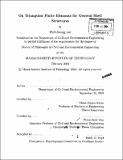On triangular finite elements for general shell structures
Author(s)
Lee, Phill-Seung, 1971-
DownloadFull printable version (10.68Mb)
Other Contributors
Massachusetts Institute of Technology. Dept. of Civil and Environmental Engineering.
Advisor
Klaus-Jürgen Bathe.
Terms of use
Metadata
Show full item recordAbstract
In general, triangular elements are most efficient to discretize arbitrary shell geometries. However, in shell finite element analysis, usually quadrilateral elements are used due to their better performance. Indeed, there does not exist yet a "uniformly optimal" triangular shell element. The work in this thesis focuses on the development of continuum mechanics based triangular shell elements (of low and high order) which overcome the known disadvantages and show uniform optimal convergence. As the shell thickness decreases, the behavior of shell structures falls into one of three categories (bending dominated, membrane dominated or mixed problems) depending on the shell geometry and the boundary conditions. We develop a numerical scheme to evaluate the behavior of shells and perform the asymptotic analysis of three shell structures. We also present the asymptotic analysis results of a highly sensitive shell problem which has a fluctuating load-scaling factor. These results provide basic information for effective numerical tests of shell finite elements. We develop a new systematic procedure for the strain interpolation of MITC triangular shell finite elements that results into spatially isotropic elements. We propose possible strain interpolations and develop five new specific triangular shell finite elements. Considering the asymptotic behavior of shells, numerical tests of the elements are performed for shell problems theoretically well chosen. We also review the basic shell mathematical model (published by Chapelle and Bathe) from which most mathematical shell models are derived. Using the basic shell mathematical model in the formulation of shell elements provides insight that can be very valuable to improve finite element formulations.
Description
Thesis (Ph. D.)--Massachusetts Institute of Technology, Dept. of Civil and Environmental Engineering, 2004. Includes bibliographical references (leaves 159-162).
Date issued
2004Department
Massachusetts Institute of Technology. Department of Civil and Environmental EngineeringPublisher
Massachusetts Institute of Technology
Keywords
Civil and Environmental Engineering.